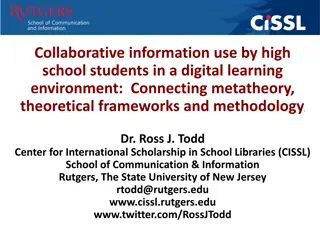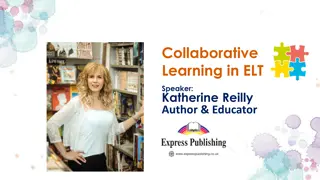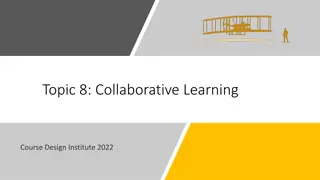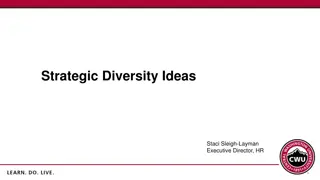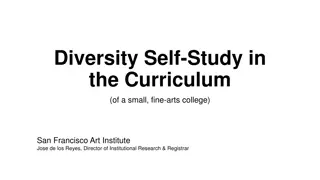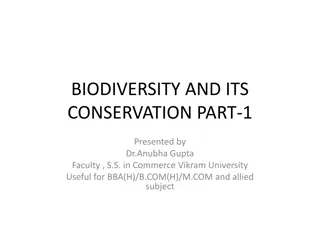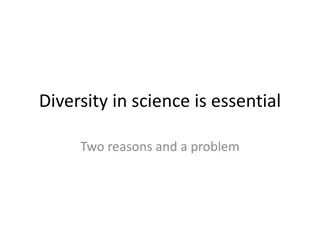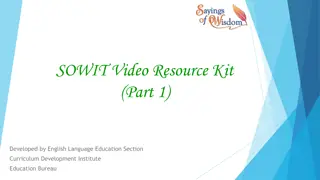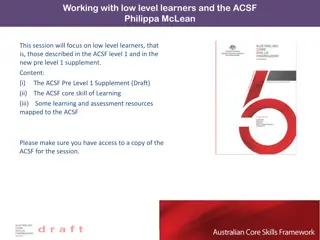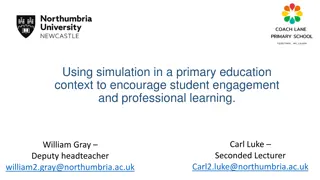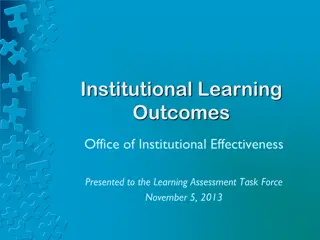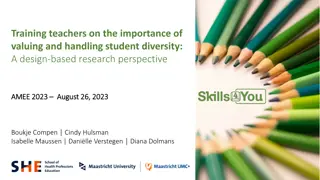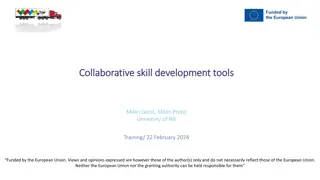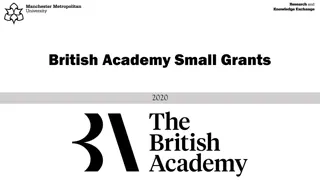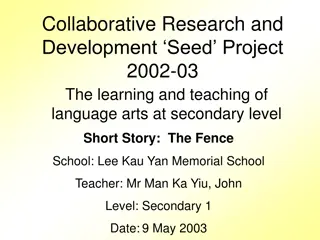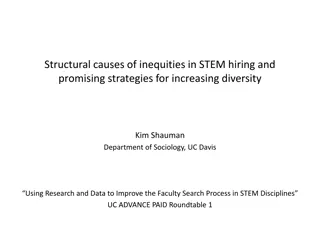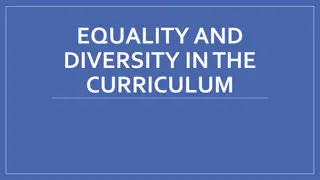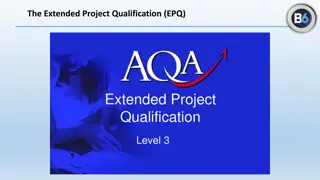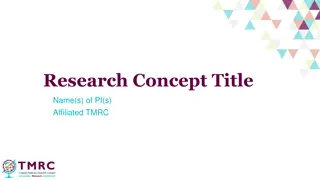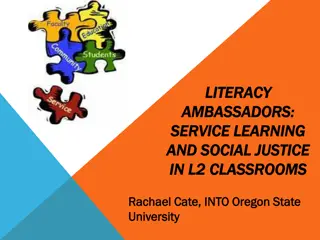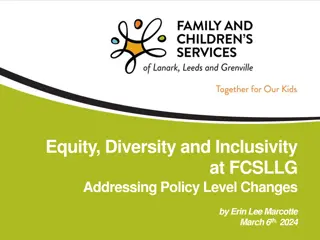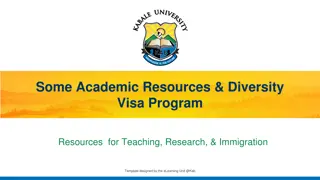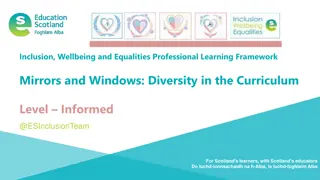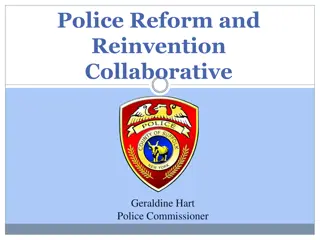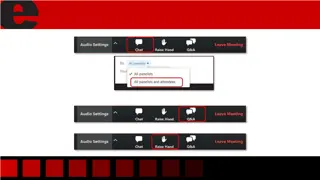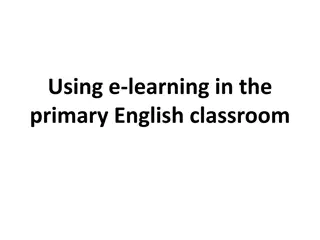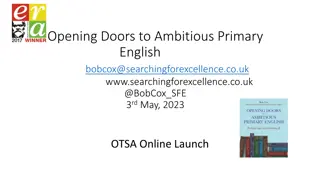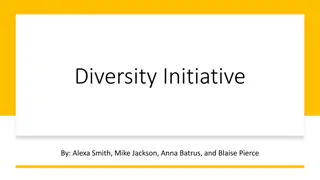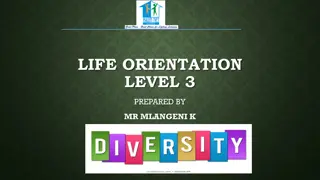Enhancing English Learning Diversity at Primary Level: Collaborative Research Project
Explore a collaborative research project focusing on effective use of resources to cater for learner diversity in English education at primary level. The project emphasizes differentiated instructions, feedback strategies, and promotion of a collaborative culture to enhance student motivation, creativity, and critical thinking skills.
- English education
- learner diversity
- collaborative research
- primary level
- differentiated instructions
Download Presentation

Please find below an Image/Link to download the presentation.
The content on the website is provided AS IS for your information and personal use only. It may not be sold, licensed, or shared on other websites without obtaining consent from the author. Download presentation by click this link. If you encounter any issues during the download, it is possible that the publisher has removed the file from their server.
E N D
Presentation Transcript
Collaborative Research & Development ( Seed ) Project for 2012/2013 Effective Use of Learning and Teaching Resources to Cater for Learner Diversity in the Learning of English at Primary Level English Language Education Section Curriculum Development Institute Education Bureau
Rundown of Todays Programme 2:00 2:10 PM Registration 2:10 2:30 PM Introduction to the Seed Project objectives and strategies used Sharing on the 1sttryout experience 2:30 3:30 PM 3:30 3:45 PM Break Sharing on the 2ndand 3rdtryout experience 3:45 4:30 PM 4:30 5:00 PM Way forward Q & A
Objectives of the project (I) Adopting the framework of differentiated instructions in planning the curriculum and designing learning tasks for KS2 students Incorporating effective learning and teaching strategies to cater for students diverse learning needs and styles Integrating textbook materials with e-learning and authentic resources to enrich the school-based English Language curriculum Using effective strategies to provide appropriate scaffolding and challenges to students of different interests and abilities in learning English
Objectives of the project (II) Developing strategies in giving constructive feedback and designing self-assessment tools Promoting a collaborative culture and enhancing professional development through co-planning, sharing of tryout experiences and peer lesson observations Raising students motivation and confidence in reading and writing a variety of text types Enhancing students creativity and critical thinking skills through integrated learning tasks Developing students information and reference skills for learning English
The framework in planning the curriculum and designing learning tasks Differentiated Instructions Content Process Product Use of different texts at a reading level appropriate for each student All students are working towards the same standards and objectives Differentiating instructions based on students learning styles Providing scaffolding for the average and less able students Giving more flexibility and challenges for the more able students The student product which demonstrates the mastery of the content: tests, evaluations, projects, reports or other activities, e.g. writing, presentation, role-play
Catering for students diverse learning needs and styles Visual Learn best by seeing Auditory Kinesthetic Learn best by hearing Learn best by doing
Integrating e-learning resources into the unit plan Catering for learners interest Motivating resources Giving immediate feedback Facilitating understanding Catering for ability Promoting learner autonomy
Promoting Assessment for / as learning to help students reflect on their learning Assessment for Learning Assessment as Learning For teacher s reference Identifying learners strengths and weaknesses in order to enhance learning and teaching For students reflection Providing opportunities for students to reflect on their learning e.g. 3-2-1 Summariser, self/peer assessment Why assessing? Mainly learners and teachers Mainly learners Whom to inform? What to focus? Providing quality feedback for learners, which entails timely support and enrichment, and helping teachers review the learning objectives, lesson plans and teaching strategies Developing students metacognitive strategies Providing opportunities for students to take charge of their own learning 8
Timeline and Workflow of the tryouts 3rdTryout 13 Jun 2ndTryout 25 Feb 1stTryout 19 Nov Sept, 2012 Aug, 2013 Questionnaires: Planning: Evaluation: Completed on 5/10 1. To identify the learning target Post tryout interview / questionnaires with teachers and students To find out the students : 2. To select / design core and extended teaching content 1. learning styles 2. e-learning experience 3. learning strategies 3. To design an overall plan E-teaching tryout: Implementation: Tryout period: 26/10 To prepare both teachers and students for the use of IT in learning and teaching.
Themes and Tasks of the Tryouts 3rdTryout 13 Jun 2ndTryout 25 Feb 1stTryout 19 Nov Sept, 2012 Aug, 2013 Theme A surprise party Travel advice Helping others - Present perfect tense - asking and answering questions - If conditional sentence - giving advice - Past continuous tense - when and while Language focus Writing about a surprise party Blog writing Presentation, Storytelling Tasks
1stTryout: A Surprise Party Differentiated Instructions Content Unit plan Process Product Learning and Teaching Strategies 1.Teaching the structure of different text types explicitly 2.Catering for different learning styles 3.Appropriate scaffolding and greater flexibility for students 4.Assessment for/as learning Open-ended writing task Learning and Teaching Materials
Unit Plan Adaptations adapt course book materials integrate selected learning and teaching resources Problems identified in the main writing task: Adaptations Not related to the context of the other activities Keep the theme of the unit, i.e. a surprise party Not meaningful task Not authentic Create a new writing task Too mechanical
Unit Plan (Coherence making throughout the learning activities) A starting point Choice of materials: Choice of materials: Context: A birthday party for a pet Context: A birthday party for Dad Motivating Having an element of surprise Appropriate level of difficulty Recycling of the language forms and functions Motivating Appropriate level of difficulty Suitable language forms and functions
Integrating e-learning resources into the unit plan Self-directed learning Teaching - e-book - e-dictionary - Websites - Practices (e.g. WLTS, PEERS, One-stop portal) - Games - Movie clip
Integrating e-learning resources into the unit plan Learning and teaching (Inside the classroom) E-book (L3) forms and functions main idea Scrambled sentence (L1) forms and functions Surprise (L3) forms and functions main idea Promoting learner autonomy Facilitating understanding Giving immediate feedback Catering for learners interest Motivating resources
Integrating e-learning resources into the unit plan Self-directed learning activities (Outside the classroom) Grammar practice (L2, 4, 5, 7, 8) forms and functions Scrambled sentence (L1) forms and functions Typing practice (L4) typing conventions E-dictionary (L5) spelling pronunciation Motivating resources Catering for ability Giving immediate feedback Promoting learner autonomy
Learning and Teaching Strategy: 1. Teaching the structure of different text types explicitly Longman Express 5A Unit 5
1sttryout: A surprise party Reading Writing Independent writing Group writing Modelling Direct explanation Students worked independently Guiding students on working in groups Demonstrating how to write a story using the creative story map Explaining the storyline to students
Learning and Teaching Strategy: 2. Catering for different learning styles Visual Using graphic organiser Using pictures / visual aids Watching video clip Auditory Kinaesthetic Group Discussion Group Activity Presentation
Enhancing students participation through kinesthetic learning activities Whole class activity: Matching game Individual work: Graphic organiser Group work: Pelmanism game Making use of graphic organisers Vocabulary learning Understanding the setting of a story
Open-ended Task: Creative story writing about a special party
Learning and Teaching Strategy: 3. Appropriate scaffolding and greater flexibility for students Support to students: For more able students Greater learner autonomy For less able students Provide scaffolding Break into steps Provide prompts Product All students achieved the learning objectives / targets The products varied in breath and depth
An example of students work from 5C Students are able to write with an appropriate story structure that comprises setting, characters, problems, events and solution use dialogues in writing use the present perfect tense appropriately use reporting words use words to link the events use adjectives to describe feelings show changes and surprises in the story It was Icy s birthday, Corina, Tony, Andy and Angel wanted to give her a nice surprise. In the afternoon, we had a party at home. Have you cooked the food yet, Tony? asked Andy and Corina. Tony answered, I have baked a vanilla cake, made sandwiches and fruit punch. And I also made some snacks for everyone. Has everything already been prepared? asked Angel. Yes, we have already prepared everything. We waited for a long time, but Icy did not return home in the afternoon. We were worried. Finally, Angel called her. When she arrived at eleven o clock, she was touched because she had a surprise party. They had a great time.
An example of students work from 5A Students are able to present main and supporting ideas and wherever appropriate Elaborate own ideas with more detailed descriptions write with creative ideas use cohesive devices use different language patterns It was Martin s birthday. My friends and I wanted to celebrate with him at my home. But Martin had something to do, so he wouldn t arrive early. Then, we decorated the house. Have you put up the balloons yet, Anson? I asked. Yes, said Anson. What have you done for the party, Addison? I asked. I have baked a cake and bought some snacks, replied Addison. We finished all the things and waited for Martin patiently. Suddenly, my phone rang. We went to the hospital quickly because Martin was in the hospital. He had a car accident. We were sad and worried about the party. When we arrived there, we saw Martin was a just a little bit hurt. Our feelings changed, we were happy. Then, we went home to celebrate with him. We played games and ate the cake.
Learning and Teaching Strategy: 4. Assessment for/as learning Formative assessment (after lesson 5) Group work: Giving feedback / Peer assessment (Lesson 10) Role of teacher: Role of students: - Effective use of assessment data to evaluate students learning - Making reflection on their own learning, especially the target language structure
Learning and Teaching Strategy: 4. Assessment for/as learning Individual work: Giving feedback / Peer assessment (Lesson 12) Role of teacher: Role of students: - Identifying students strengths and weaknesses Providing constructive feedback - Making reflection on their own learning, especially the writing skills Making improvement based on feedback from teachers and peers - -
Teachers Feedback Unit Plan the lessons are coherent with a progressive development of language and writing skills Learning and Teaching Effectiveness the writing task can develop the students creativity through the story reading and group discussion, students can generate more ideas and have more confidence to finish their individual writing Learning and Teaching Materials Areas for improvement it is worthwhile to use e-learning materials as students are more motivated the vocabulary building needs to be further developed and consolidated peer assessment is worth doing, it was quite demanding for students to proof-read the whole authentic text
2ndTryout: Travel Advice Differentiated Instructions Content Unit plan Process Product Learning and Teaching Strategies 1.Teaching the structure of different text types explicitly 2.Catering for different learning styles 3.Appropriate scaffolding and greater flexibility for students 4.Assessment for/as learning Open-ended writing task Learning and Teaching Materials
Unit Plan Problems identified Reading text: unfamiliar context (a story about alien s travel experience to the earth) Main writing task is too easy for Primary 5 students Adaptations Reading text: Replaced by a poster on Taiwan Cycling tour Integrate selected learning and teaching resources with the textbook materials Main task: Blog writing
Learning and Teaching Strategy: 1. Teaching the structure of different text types explicitly Theme: Travel advice Introducing the text type features of a poster Providing steps for students to read a poster, e.g. looking at the pictures and captions and reading the title to understand the gist, reading the, headings, and sub headings to find out the relevant information Helping students to analyse the text type features of a blog writing
Unit Plan 2ndtryout: Travel advice Reading Writing Independent writing Group writing Modelling Students worked independently Input Guiding students to generate ideas and work in groups Introducing the text type features of a blog Using jigsaw reading to help students understand the cycling tour
Learning and Strategy: 2. Catering for different learning styles Students are practicing the target language forms through playing the board games. Students work cooperatively and attentively. This activity traces them to the final task. Designing open-ended task using the RAFT model Role A member of the cycling tour Audience Parents or friends of the participants Format A blog Topic More able broke missed lost bad weather Average lost broke Remedial bad weather
Open-ended Task For less able students Provide prompts More support Fewer variety of topics Day 5 of the Cycling Tour: All our suitcases were lost For more able students Greater learner autonomy Less support More variety of topics Group Work Oh no! Where are the suitcases? Individual Work Today was the 5thday of the journey. We rode the bike in the afternoon. Then we went to had eat something. When we went back to the hotel, everyone yelled, Where are the suitcases? We ran to the ground floor and asked the people in the hotel, Where are out suitcases, we asked. Look at the bike, The tyre broke It was Day 7 of the cycling tour. I was so delighted to see the sun shining brightly in the morning. We had a long ride on the highway. The scenery was beautiful. I can see a lot of mushrooms. Suddenly, Mandy cried, My bike is broken! I cannot continue cycling. Oh! Let me call everyone to look for them, if we find them, we will call you. Please give us your phone number, they said. Ok! We will wait, Miss Lau said. A few more hours later, a guy called us. In fact our suitcases were in the room near us, so we ran to the room and got them back. We were lucky, I said. Miss Lau said it was important to put the things tidily. We were fortunately to find a bike shop. We changed a new tyre but it was very expensive. We learnt the tyre changing skills. it was important to bring a spare tyre. If we broke the tyre we should went to the bike shop. Thanks for reading my blog. If you like, you can leave me comments. Thank you for reading my Blog. I ll tell you more about the tour tomorrow.
Extension activity: e-learning at Easter holiday 1. Assigning holiday homework through the blog Online reading and summarising the story Providing a platform for teachers and students to communicate in English outside the classroom. Providing an opportunity to read in an authentic situation and share their own experiences / feelings. 2. Sharing daily life experiences 3. Publishing students good work A platform for sharing the class work and celebrating success.
Students Feedback 3.2 It is helpful to learn the features of different text types 1st 3.1 The online resources and the blog are interesting and useful 3.0 2nd 3rd 2.9 Mean score 2.8 2.7 I can learn more effectively through discussion with classmates in English lessons Learning the features of different text types can help me understand the texts and complete the writing task Mind maps are useful for me to learn the new words, understand the structure of a text, organise my writing ideas Note-taking skills can help me find out the key points of the texts I think it is meaningful to use the blog to share and communicate with my teachers and classmates in English I think the blog is a good platform for sharing my classmates' writings I think the online resources is interesting and useful
Teachers Feedback Learning and teaching effectiveness: Students have a steady improvement in writing Peer assessment: Students are more familiar with the peer assessment which helps students evaluate their own learning Suggestions: 1. Designing interesting speaking tasks 2. Introducing speaking strategies to improve students presentation skills
3rdTryout: Helping Others Differentiated Instructions Content Unit plan Process Product Learning and Teaching Strategies Teaching the structure of different text types explicitly Catering for different learning styles Appropriate scaffolding and greater flexibility for students Assessment for/as learning Learning and Teaching Strategies 1.Teaching the structure of different text types explicitly 2.Catering for different learning styles 3.Appropriate scaffolding and greater flexibility for students 4.Assessment for/as learning Presentation Role play / Storytelling Learning and Teaching Materials Learning and Teaching Materials
Unit Plan 3rdtryout: Helping others Listening Speaking Group work Guided Practice Modelling Students worked collaboratively to tell a story Lead in Guiding students to use notes taken to retell the story -Making use of mind map to generate ideas, -Demonstrating and explaining what note- taking is -Using connectors to organise a story Introducing the use of online resources to help students generate ideas in a speaking task
Impact on students more motivated to learn English because of the interesting topics and resources, as well as the meaningful tasks more positive attitudes towards English writing and speaking activities making use of e-learning resources both inside and outside the classroom Learning attitude using the target language forms and functions in writing and speaking tasks using the story map that comprises the 5 elements to write and present a story Learning outcome making use of graphic organisers in vocabulary learning and writing making use of framework/structures to generate and organise ideas Having greater awareness of using different learning strategies, e.g. note-taking, high-lighting keywords Language development strategies
Impact on teachers Making a clear connection between pre-tasks and the main task Introducing learning strategies explicitly to students Integrating different resources into the lessons Making use of the e- resources and tools in the L&T process L&T Unit Plan resources Assessment for learning L&T effectiveness Helping the less able students achieve the learning objectives Stretching the ability of the more able students Designing task specific assessment rubrics Reinforcing peer assessment through modelling and constructive feedback
Way forward Forming teacher network to facilitate professional development Sharing teaching resources among schools of similar needs Helping students to reflect on their learning through self/peer assessment Helping students to develop metacognitive learning strategies Teachers Students Further enhancing the materials development at KS2 Exploring strategies to cater for learner diversity at KS1 Curriculum
Networking activities in Year 2013-14 Networking activity 2: Professional sharing on school-based materials developed by Network schools Mar 2014 Networking activity 1: Professional sharing on tryout materials Dec 2013 Workshop on Using Differentiated Instruction to Cater for Learner Diversity in the English Classroom Oct 2013


